In each edition of Gimmick Some Lovin', we take a look at one iteration of a gimmick match available on the WWE Network. Some are iconic for their success, others for the extent to which they flopped, and some just... happened.
We defined a "gimmick match" as, in any way, adding a rule/stipulation to or removing a rule from a match, changing the physical environment of a match, changing the conditions which define a "win", or in any way moving past the simple requirement of two men/women/teams whose contest must end via a single pinfall, submission, count out, or disqualification.
We've spent the last few articles looking at matches featuring strange structures, stranger rules, and Ric Flair taking abuse, but they've mostly turned out to be enjoyable experiences; as with our first venture into World Championship Wrestling territory, let's dig in to a dud combining all of those things: The Doomsday Cage Match from WCW Uncensored 1996, featuring Hulk Hogan and Randy Savage versus almost every heel on the WCW roster, namely the Dungeon of Doom and the Four Horsemen, aka The Alliance to End Hulkamania.

WCW Uncensored
Professional wrestling in the mid-1990s was facing an identity crisis: the World Wrestling Federation and its closest competitor, WCW, were selling almost exclusively to their core demographic in families and young children. Both companies' product was marked by bright colors, broad characters, and heels and babyfaces defined as strictly as possible.
This approach was met with much derision in popular culture; between the performers seemingly going straight from one job to the ring (like I.R.S., Duke "The Dumpster" Droese, or Bob "Spark Plugg" Holly, among many others) and men whose seeming hatred led them to threaten each other with the mildest of language, wrestling seemed to be at its silliest.
However, an upstart company on the East Coast sought to change all that, and presented a show that proudly flaunted wrestling's silly stereotypes. Extreme Championship Wrestling gave its viewers more violence, bloodshed, and sexual content than the two biggest companies could dream of, and readers of magazines like Pro Wrestling Illustrated began noticing the stark differences between ECW and the shows getting nationwide attention.
ECW's notoriety among adult wrestling fans, alongside the children WCW and WWF tried to reach who were now ageing into their teens, put pressure on the Big Two to adopt more extreme influences into their own shows. The WWF began easing up on language restrictions while introducing more frequent (and more intense) no-holds-barred brawls, not to mention envelope-pushing characters like Goldust and Mankind.
WCW, on the other hand, created an entire annual show dedicated to allegedly easing their notoriously strict restrictions on the matches their performers produced, Uncensored. Featuring future entries in this series like the "King of the Road" match between Dustin Rhodes and the Blacktop Bully (which, contrary to the show's title, was heavily edited to censor the presence of blood, for which both competitors were fired) and a strap match between Hogan and Vader, the show was an unmitigated failure.
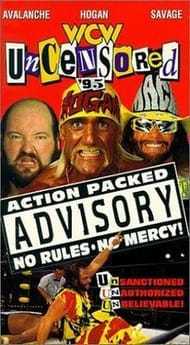
Two matches on the show failed to crack a positive star rating from Dave Meltzer, and the highest-rated match was the Hogan-Vader strap match main event where Hogan managed to win by beating, you guessed it, Ric Flair, getting 3.5 stars.
For 1996, the company decided to up the ante with more matches, fewer stipulations, and a massive and convoluted structure which would play host to the most lopsided handicap match not booked by The Authority (and one guess as to who does the job).
Changing of the guard
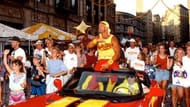
Two big changes in the mid-90s radically altered the face of WCW, which had grown out of the National Wrestling Alliance and saw itself as continuing a long tradition of old-school, more mature professional wrestling.
The first was the hiring of former WWF Champion and apparent retiree Hulk Hogan; upon turning real-life heel on his former employer Vince McMahon during McMahon's federal trial over steroid charges, Hogan seemed intent on leaving the world of sweat and spandex behind in favor of a different type of fake fighting: B-movies and cable television beach dramas.
WCW, however, and its billionaire owner, Ted Turner, wanted to wring the wrestling crown away from McMahon's WWF, and thought the perfect soldier to win the war was Hogan, the man whom McMahon had used to vault himself so far into first place. WCW enticed Hogan to come south with guarantees like near-total creative control, a lighter work schedule, and guaranteed jobs for Hogan's friends.
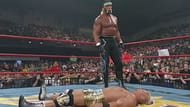
WCW began to strongly resemble the WWF in the late 80s/early 90s (or TNA in the aughts), as respected veterans like Sting, Flair, and Vader gave way to Hogan, Savage, Mr. T, "Hacksaw" Jim Duggan, The Nasty Boys, and, yes, Beefcake. Determined to make lightning strike twice, WCW's formula for success was "sign the guys that used to be big up North, but older and fatter".
Further complicating matters was the promotion of third-string announcer Eric Bischoff to WCW president; Bischoff had an eye for media and flashy presentation, but detested nearly anything that too closely tied WCW to its southern roots. Starting with his debut match at Bash at the Beach 1994, Hogan would go on to beat Flair no fewer than four times on pay-per-view (including once for the WCW Title, once for Flair's career, and once in a match where Flair wasn't even booked).
Sullivan, my son
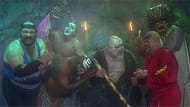
Hogan's tenure at the top changed the dynamic of WCW's booking; with Flair as "The Man," the company stayed true to its traditional roots as a "heel territory." Tickets and PPVs were sold on the notion that fans might finally get to see Flair (or the villain du jour) finally get his comeuppance (though he usually would not, albeit just barely).
Hogan, though, was the biggest goldmine babyface the industry had seen up until that point, and, until dire straits forced WCW to explore a nuclear option in the summer of 1996, he needed to be on top and to do so as a good guy. Ergo, WCW needed challengers, and since look always trumped talent in Hogan's eyes, The Hulkster and WCW booker Kevin Sullivan crafted a stable of vaguely-evil WWF castoffs to make Hogan's life hell.
With Sullivan as its "Taskmaster," the Dungeon of Doom formed in late 1995 to, in kayfabe, rid the world of Hulkamania (but, in real life, to try to cajole frustrated WCW audiences to stop booing the yellow-and-red-clad Orange One).
The Shark (formerly Avalanche, who was formerly Earthquake), Kamala, The Zodiac (aka The Booty Man aka The Butcher aka Brutus Beefcake), Meng, and a debuting Giant (later "The Big Show") masquerading as Andre the Giant's long-lost son all followed Sullivan's lead in attempting to destroy Hogan through cheesy vignettes, badly-constructed sets, and weird/awkward/ineffective bearhugs.
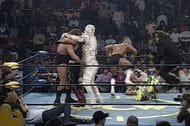
Giant managed to steal the WCW Championship from Hogan, and the longest stretch of Hogan not holding WCW gold would last from Halloween Havoc 1995 until August 1996's Hog Wild event. During that time, Hogan would fend off his own growing irrelevance, alongside the Dungeon of Doom's army of monsters hellbent on ending Hulkamania as we knew it.
The Rules

According to Tony Schiavone, "the rules are simple."
Hogan and Savage must start at the top of the cage, and have to "win" each cage to proceed to the next; their heel opponents may defeat Savage or Hogan via pinfall or submission at any time, of course, but it's as likely as Dusty Rhodes' commentary making any sense at all.
Bobby Heenan, for his part, reiterates that this is Uncensored and a blood feud and the rules don't matter. Dusty then cuts a promo where, without a trace of irony, he proclaims that "Hulk Hogan led us through the 80s and is leading us into the 90s".

The match
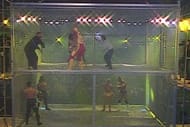
Michael Buffer introduces the match, the cage, and the entire heel team, probably getting paid more than I owe in student loans to do so. All eight men enter to the same ominous music and take their places in various spots in the structure.
Buffer also seems to take more time saying "Hulk Hogan" than he does at least half of he heel team combined.
Hogan and Savage start in the top cage with Flair and the man once thought to be too dignified for something this absurd, Arn Anderson (who wrestles in his best K-Mart sweatsuit) while Heenan and Rhodes try to make this contest sound important and worthwhile.
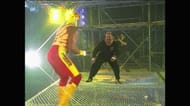
Do you like bad working punches, rest holds, and dinosaurs no-selling what was supposed to be a devastating hold from NWA legends? If so, the top cage is for you! Hogan and Savage take advantage of a handful of powder to the heels' eyes to exit that cage via a trapdoor (YOU DIDN'T MENTION TRAPDOORS, TONY!), which apparently means they won the cage, so they enter the next tier with Sullivan, Lex Luger, Meng, and The Barbarian.
Somehow, Tier 2 has a door with a wall running down the middle, and Hogan (conveniently) manages to trap The Faces of Fear in one half (locking the door with a chain Sullivan had used to choke the Great Orange One) so he and Savage could focus on battling Luger and Sullivan.
Hogan meekly teases murder, ever so slightly trying to nudge Sullivan off the scaffolding surrounding the cage, which would result in The Taskmaster being as dead as this Tupelo crowd. They can't see anything at all, and they make about as much noise as a Prius engine.
Nonsensically, Hogan, Savage, Sullivan, and Luger end up on the floor, making their way to the one place we were promised would not come into play: the ring (also, I think at one point, escape was mentioned as a means to victory, but no bell sounds).
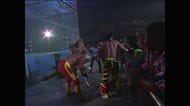
Somehow, the crowd comes alive when they're actually able to see the match (strange how that works), and they go mildly bonkers when Hogan Hulks Up in the ring against Luger. At portions of the match, the producers engage a split-screen presentation to focus on both Hogan and Savage; there's an extended portion, though, when both men are on the exact same side of the ringside area (doing the exact same amount of nothing) but the split-screen remains, because WCW reasons.
The (unfortunately named) Ultimate Solution and Zeus Gangsta enter to drag the faces back into the cage, placing them into the ring contained in the lower tier while definitely-not-piped-in Hogan chants ensue. The solution, by the way, doesn't just sound like he walked out of a neo-Nazi rally; his shaved head and beer belly make him look like he'd be right at home marching with tiki torches.
Hogan saves Savage from a bearhug applied by the untrained co-star of a ten-year-old box office flop, and Gangsta responds by holding Hogan to the mat with a limp choke (while Ultimate Solution gives us our third actual wrestling move by gorilla pressing Savage).
Flair and Anderson (allegedly eliminated by means of trapdoor-finding) re-enter the match, because who else on this team of nobodies and a handful of stars could do the job in this one? Anderson, at least, has finally dressed for the occasion, shedding his sweatsuit in favour of traditional trunks.
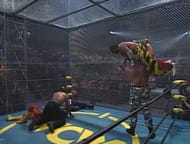
Handfuls of powder to the heels' faces are followed by feeble shots from Dollar Tree frying pans provided by Beefcake, giving Hogan and Savage a temporary advantage. Luger shows back up with the most dastardly weapon of all: a single glove! Luger accidentally nails Flair, giving Hogan and Savage the opportunity to escape (again, but this time apparently for the win).
Savage, however, realizes this is WCW in 1996, and there's only one way to end a PPV, so he goes back to pin Flair. He and Hogan collapse in exhaustion and elation while the heels stand around like Scooby Doo villains rueing their bad luck to send this awful show back to the announce team.
My Rating
My three-year-old son is in a phase where he's obsessed with talking about "bad guys" and "booby traps". He's always talking about how the "bad guys" are trying to trap us, and the way they will try to do it is by "making plans," "setting booby traps," and "doing bad guy things".
Either he booked this match, or Hogan did while finishing off the large pile of illicit drugs he and McMahon were rumoured to have shared while coming up with the film No Holds Barred in the 1980s.
In most fictional media, an 8-on-2 advantage is meant to build tension and let the audience worry about how their protagonists might survive to see another chapter; in this match, it simply makes one wonder who is going to eat the pin, and why it's Ric Flair (whose name, somehow, Buffer mispronounces).
WCW apparently only learned from ECW's influence that viewers wanted an exponential increase in stuff, things, weapons, and bodies; between the convoluted story and rules, the lack of any visible passion from anyone involved, and half-hearted punches and kicks thrown throughout, it's clear that effectively connecting with an audience was not a Philadelphia staple that WCW was willing or able to try.
To say that everyone sleepwalks through this "contest" would be insulting to the notion of sleepwalking. Every heel, regardless of his resume, is treated like a nobody and turns in a nobody level of effort. Hogan and Savage, meanwhile, are at their most self-aggrandizing, and it's clear why audiences had been turning on The Hulkster throughout much of 1995 and 96.
I couldn't give the "Pills on a Pole" match an integer rating because of its poor quality; this one is so much worse, it doesn't even deserve a number. I officially rate this one:
💩/10
Meltzer says:
Meltzer gives this one a generous negative three stars, and it's a wonder how much worse this could be to lose those final two stars.
Send us news tips at [email protected]
What makes Sting special? His first AEW opponent opens up RIGHT HERE.
